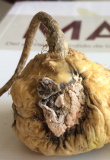What are the different types of maca to eat?
There are five main different forms of maca, each having different properties and characteristics. Knowing which form of maca you have is important as it determines how it should be consumed and what benefits it can give you.
Always check the label of any maca product to understand which preparation you are dealing with and then you can follow the correct instructions on how to consume it to ensure you are getting the health benefits and not putting your health at risk.
Fresh maca (Maca fresca) – In Peru maca is rarely consumed fresh as it is claimed that it is not medicinal until after being dried. Despite being a good source of carbohydrates, minerals, fatty acids and glucosinolates fresh maca is almost devoid of bioactive macamides, the key therapeutic components in maca. If fresh maca is consumed it is usually boiled and processed like a potato in soups or stews as a source of carbohydrates and minerals.
Dried maca (Maca seca) – The most commonly consumed form in Junin (Peru) is dried maca, which is obtained by naturally air drying fresh maca at altitude for 3 months during the dry season of July-October. Dry maca is usually consumed by boiling into teas, porridges, soups and stews. Commonly consumed Incan tea from the region of Junin is a mix of cinnamon, cloves, dried maca pellets and often pieces of fruit like green apple, pineapple or peach. It is sometimes mixed with quinoa or oats to form a runny porridge that is consumed with milk in the mornings. Dried maca has been shown to have 10x higher levels of total macamides compared to fresh maca and is considered more bioactive and preferable for therapeutic use.
The 5 main preparations of maca and how to consume each.
Maca is available for export in 3 different powdered forms – raw maca, activated (gelatinised) maca and atomised (extracted) maca.
Raw maca (harina de maca) is the result of milling the dried maca roots to form a fine powder. Raw maca has a high starch, bacteria, yeast and mould. It is always boiled and cooked to ‘activate’ the macamides and protect the stomach from high starch levels, glucosinolates, mould and aflatoxins. It is often boiled into tea, porridges, soups and stews or used in baking. Raw maca by itself has a strong ‘earthy’ flavour and is quite tart and odorous, leaving a not so pleasant taste in the mouth. To understand more about the risks of eating raw maca and why it needs to be cooked read here.
Activated (gelatinised) maca (maca gelatinizada) is the most versatile form of maca to consume as it can be cooked or eaten straight in raw foods. It is formed by pressure heating raw maca powder at 140o C for approximately 10 seconds in an industrial technique that simulates traditional Incan cooking. The result is a more potent bioactive powder with a higher macamide concentration, low starch content and is sanitised to protect your gut biome. Activated maca has a sweeter, more palatable malt caramel flavour and can be eaten with or without cooking. Activated maca has become the most popular exported powder out of Peru as it is the most versatile and ideal for western style foods like smoothies, bliss balls, lattes and raw food applications.
NB activated (gelatinsed) maca Does NOT contain gelatin – it is 100% vegan friendly.
Atomised (extracted) maca (extracto de maca) is a pre-cooked extraction of raw maca from water and plant based alcohol. It is designed to simulate traditional maceration of dry maca roots in order to concentrate the bioactives. The spray dried powder is a high potency formula of maca that is 10x more active than raw maca. It has a very high macamide concentration and is designed for specific therapeutic use in treatment of acute or chronic conditions. The powder rapidly absorbs water and oxidises so it must be stored in air-tight containers and away from moisture. It is ideally consumed straight in water, tea, juices or smoothies and has a sweeter caramel flavour.
Raw maca powder must always be cooked before use.
Activated maca is ready to eat and requires no cooking.
Atomised maca is the high-dose extract of raw maca used for treatment of acute or chronic conditions.
Raw maca (left) Activated maca (middle) and Atomised maca (right) in water demonstrating the consistency and starch contents of the powder.
Note: There is no upper limit with maca and everybody is different, so it is important to find your ideal dose that is right for your body, for some this may be less than the recommended for others it may be more. If you experience positive health benefits then we suggest you continue treatment at that ideal dosage. The material provided on this website is for information purposes only. It is not intended to replace medical advice or be a treatment for any medical condition. Users should consult a health professional if you have any concerns about your health, are starting any health or nutritional related treatment, or for any questions you may have regarding your own or any other party’s medical condition. Information and statements regarding dietary supplements have not been evaluated by the Food and Drug Administration and are not intended to diagnose, treat, cure, or prevent any disease.











